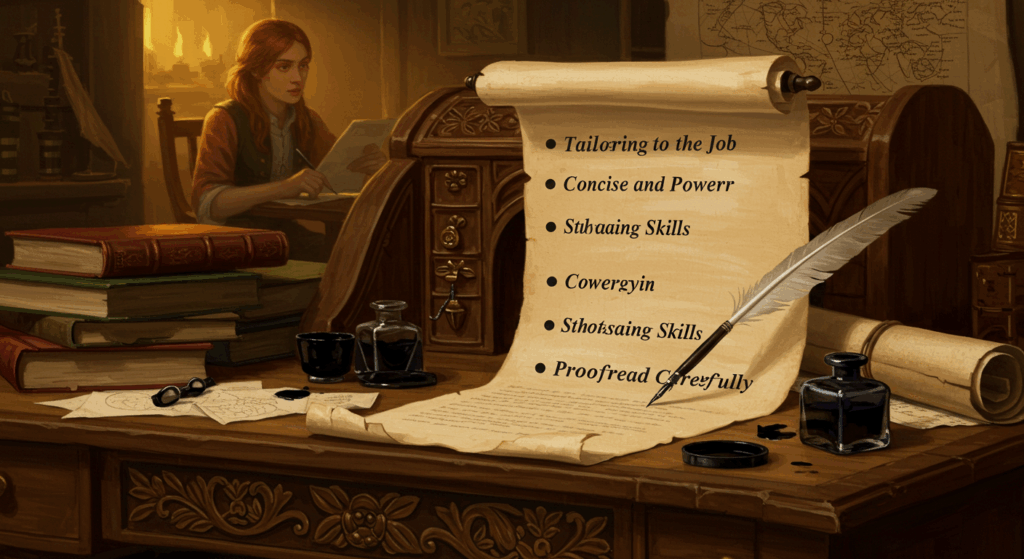As we know, cover letters have a reputation like kale smoothies. Everyone says they’re good for you, but you’re low-key suspicious and kinda hope nobody notices you skipped it. If you’ve ever stared at a blank Google Doc thinking “what even is this thing,” same. Let’s demystify it together.
A cover letter is the little story that makes your resume make sense. It’s the “here’s why I’m the right person, right now” message that bridges the gap between who you are and what the role needs. If your resume is the facts, the cover letter is the vibe—the context, the energy, the receipts. It’s where you prove you read the job post (lol), show you get the company, and make the hiring manager feel something other than “next.”
Oh, and before we go deeper, three things we’ll keep coming back to: definition, types, importance. Those are like the Netflix categories of cover letters—knowing them helps you find what fits your situation without scrolling forever.
The definition (in normal-human language)
A simple definition that actually helps
Here’s the clean definition: a cover letter is a short, personalized note (usually 250–450 words) that accompanies your resume and speaks directly to the hiring manager about why you’re a fit. It connects your experience to the job’s goasls, using real examples, in your voice. Think “mini-pitch,” not “life story.”
What a cover letter is not
- Not a resume remix with fancy adjectives.
- Not a novel (save the plot twists).
- Not a generic “To whom it may concern” email you send to 87 jobs.
- Not a flex thread with zero empathy for what the company needs.
Why recruiters still care (promise)
Even in the era of AI and ATS bots, humans read cover letters—especially at the final screens, smaller companies, startups, and roles where communication matters (marketing, ops, product, design, HR, customer success). Your letter shows how you think, not just what you’ve done. It’s a quick audition for your working voice. The importance here is huge: clarity + relevance = interviews.
Why cover letters matter (a.k.a. the importance)
The three big reasons (tattoo these in your brain)
- Context: Your resume says what. The cover letter says why it matters. That “why” is the importance piece.
- Relevance: You map your skills to their goals. That’s how you go from “cool background” to “we need this person.”
- Connection: People hire people they like and trust. Your letter adds personality, empathy, and a bit of spark—without being cringe (we’ll keep you safe).
But ngl… do all jobs read them?
No. Some postings literally say “no cover letters”—in which case, don’t force it. But when a posting is competitive or asks for one, or when you’re changing careers, returning to work, or your resume has funky gaps—your letter can be the difference between “hmm maybe” and “book the call.”
The main types (choose your own adventure)
When people say “cover letter,” they often mean the standard version. But there are different types that fit different situations:
1) The classic application letter
You’re applying to a posted job. You analyze the job description, mirror their language lightly, and show 2–3 wins that map to the role’s top outcomes.
Use when: There’s an actual listing and you meet most requirements.
Goal: Demonstrate immediate value.
2) The referral letter
Someone inside the company recommended you. You lead with the referral, then connect your experience to the team’s current priorities.
Use when: A friend or former colleague passed your name along.
Goal: Leverage trust; make the hiring manager’s life easy.
3) The networking / speculative letter
There’s no posting (or it’s vague), but you’re pitching yourself to a team. You’ll show you understand the company’s stage and propose concrete ways you could help.
Use when: You admire the company and want on their radar.
Goal: Start a conversation, not necessarily a formal process.
4) The career-change letter
You highlight transferable skills, relevant projects, and training, and you show how your past strengthens your new path.
Use when: Your resume isn’t a neat 1-to-1 match.
Goal: Reduce risk by making the bridge obvious.
5) The return-to-work letter
Maybe you took time off (study, caregiving, travel, health). You own the gap gracefully and spotlight momentum, updated skills, or freelance/volunteer work.
Use when: There’s a gap and you’ve grown through it.
Goal: Reassure and re-energize your profile.
6) The internal mobility letter
You already work there and want to move teams. You connect company context you already undserstand with the new team’s needs.
Use when: Lateral move or promotion.
Goal: Show velocity + cultural fit.
7) The ultra-short email cover note
Some hiring managers live in email. You write 5–7 punchy lines that nail fit, include 1–2 metric-backed wins, and link portfolio/resume.
Use when: The application flow is informal or via direct email.
Goal: Respect time; still sell your fit.
Knowing these types helps you pick the one with the most importance for your situation—no more sending the wrong vibe.
The anatomy (structure that doesn’t feel robotic)
Even if we’re keeping it human, a little structure saves you from the “where do I start??” spiral.
Header & hello
- Your info, their info (if in a doc; email can be simpler).
- A specific greeting. “Hi Maya and the Growth Team,” beats “To whom…” every time.
Hook: your opening line
Grab attention with relevance, not fluff.
- Name the role + why you care.
- Drop a quick proof point.
- Connect to the company’s mission or recent move.
Value: 2–3 mini stories
Use short paragraphs or bullets. Each one should:
- name the business problem, 2) show what you did, 3) end with a result (numbers help).
Keep it tight: achievement > activity.
Alignment: mirror their goals
Show you’ve read the JD. Pick 2–3 core needs and say how you’ll hit them. Don’t copy/paste the whole posting (pls no).
Close: energy + logistics
Re-state your fit, thank them, and include a small call-to-action (availability, portfolio, etc.). Add a tasteful P.S. if you want a little extra sparkle.
A quick template (steal this, customize fast)
Subject: Product Marketer applying to accelerate PLG growth (ref. Jay Chen)
Hi [Name] and the [Team Name],
I’m applying for the [Role] because I love how [Company] turns [audience/problem] into [value]. In my last role at [Prior Company], I led [project] that lifted [metric] by [X%]—the kind of experiment stack I’d bring here.
- Launched [initiative] to solve [problem]; A/B tested [thing]; outcome: [metric shift].
- Partnered with Sales on [process]; shortened cycle by [X days]; revenue up [Y%].
- Built content + lifecycle flows for [segment]; activation +[X%].
Your posting calls for someone who can [priority]. That’s my jam: I’ve shipped [similar work] and I’m already sketching ideas for [Company] around [idea 1] and [idea 2].
Would love to chat next week—my resume and a short case study are attached. Thanks for reading!
Best,
[You]
P.S. Loved your recent launch of [feature]—nice balance of clarity + personality.
Use this as a base no matter which types you pick. The definition stays the same; the importance is your storytelling.
Writing style that feels human (and ATS-friendly)
Human voice rules (without oversharing)
- Write like you talk… after one coffee, not three.
- Keep sentences active: “I led,” “I shipped,” “I analyzed.”
- Avoid filler like “I’m passionate about synergy” (no one is).
- Sprinkle casual asides (“ngl,” “you know,” “hmm”) lightly—one per section is plenty.
Keyword reality (the ATS part)
- Use 6–10 keywords from the posting naturally.
- Prioritize role-critical phrases (e.g., “customer retention,” “SQL,” “Figma prototypes”).
- Don’t keyword-stuff. Read it out loud; if it sounds like a robot, edit.
Numbers > adjectives
“Reduced churn 18% in Q2” > “I’m very result-oriented.” Metrics are your best friends.
Format basics
- 250–450 words (unless otherwise asked).
- One page max for a doc; 5–7 lines for an email note.
- 11–12 pt readable font, normal margins.
- PDF if you upload; plain text if the form wants text.
Mini-library of openings (plug-and-play)
- The Mission Hook: “I’m applying to help [Company] make [industry] more [adjective], because I’ve seen how [problem] blocks [users].”
- The Metric Hook: “At [Prior Company], I grew [metric] by [X%]—I’d love to bring that energy to [Company]’s [team].”
- The Product Hook: “Your rollout of [feature] nailed [value]. I’d love to help ship the next wave of [outcome].”
- The Referral Hook: “[Referrer] suggested I reach out about [role]. We partnered on [project], and they thought my [skill] fits your roadmap.”
- The Change-Maker Hook: “I’m shifting from [old field] to [new field] after building [transferable wins]. Here’s how that helps [Company] right now.”
Examples by type (short and sweet)
Career-change snippet
I’m moving from hospitality ops to customer success. In my last role, I handled 60+ customers per shift, resolved escalations, and launched a new feedback loop that raised NPS 22%. Those same listening + ops skills are exactly what your CS team needs as you scale self-serve accounts.
Referral snippet
[Referrer] and I built a lifecycle program that turned free trials into revenue (+31% MRR in 90 days). They pointed me to your lifecycle marketer role—happy to share the flows and experiments I’d start with here.
Networking snippet
There’s no posting for a conmunity role right now, but I’ve been an active user of [product] for a year and see growth opportunities around onboarding challenges, office hours, and UGC wins. If it’s helpful, I drafted 3 quick experiments below.
Common mistakes (and easy fixes)
Mistake: “I love your company since childhood.”
Fix: Tie love to a current business reason, not nostalgia.
Mistake: Generic everywhere letter.
Fix: Customize the first paragraph + 2–3 achievements to the JD.
Mistake: Over-apologizing for gaps or changes.
Fix: Own it briefly, then pivot to momentum and proof.
Mistake: Listing everything you’ve ever done.
Fix: Show only what proves you can do this job.
Mistake: Buzzword salad.
Fix: Replace adjectives with outcomes and numbers.
Mistake: Asking for training in the letter.
Fix: Show self-led learning + projects you’ve already completed.
How to customize in 9 minutes (not kidding)
- Skim the JD and star 3 priorities.
- Mirror the language for those 3 things (lightly, no copy pasta).
- Pick 2–3 wins from your resume that match those priorities.
- Write a one-line hook that blends mission + metric.
- Draft the bullets (problem → action → result).
- Add one sentence that shows you get their product/audience.
- Close with a CTA (availability + portfolio/case study link).
- Read out loud (cut filler; keep your voice).
- Save a base version you can tweak for the next application.
What to do if you don’t have “big” numbers
- Use ratios or ranges (e.g., “shortened onboarding from ~3 weeks to ~10 days”).
- Use quality signals (CSAT, NPS, support tickets down, cycle time).
- Use project scope (team size, budget, markets launched).
- Use social proof (testimonial snippet, internal award, cross-team adoption).
- Use before/after stories—micro transformations count.
Sample one-page letter (quick demo)
Subject: Ops Generalist who scales scrappy systems into smooth ones
Hi Rina and the Operations team,
I’m applying for the Operations Associate role because I love how Lumen makes complex logistics almost… chill? At Pivota, I rebuilt our intake + routing flow and cut response time from ~36 hours to under 8 while saving the team ~12 hours/week—systems nerd here, hi.
- Standardized vendor onboarding docs; error rates dropped 41%.
- Mapped handoffs across Sales → Ops → CS; reduced “where is this?” pings 58%.
- Built lightweight dashboards in Sheets + Looker; leadership finally saw bottlenecks in real time (we fixed two in the first month).
Your JD calls for someone who can automate repetitive work, document processes, and level up cross-team collaboration. That’s been my last two years. If helpful, I already sketched a v1 of an “ops triage” board I’d test here.
Would love to connect next week—my resume + a mini case study are attached. Thanks for reading!
Best,
Sam
P.S. Your blog post about service design hit—love the balance of rigor + humor.
FAQs you might be thinking (because same)
Do I always need a cover letter?
No. If the portal doesn’t ask and you’re short on time, prioritize a tailored resume. But if you’re borderline qualified, changing lanes, or the posting values communication, the importance of a tailored letter goes way up.
How long is too long?
If someone has to scroll on mobile more than once, it’s long. 250–450 words is the sweet spot. For the types that are emails, think 5–7 lines.
Can AI help?
Sure, but keep ownership. Use AI to brainstorm phrasing or edit for clarity. Keep your stories and numbers real. If it reads like a bot, hiring managers can tell (and they get tired).
Should I repeat my entire resume?
Nope. Pick 2–3 highlights that map to the role. Your letter is the trailer, not the movie.
What if I’m early career?
Use projects, internships, campus orgs, freelance gigs, and class-built work. Translate duties into outcomes (what changed because of you). It still counts.
Power words & phrases (drop these in, mean them)
- “shipped,” “scaled,” “unblocked,” “accelerated,” “reduced,” “increased,” “optimized,” “led,” “launched,” “synthesized,” “de-risked”
- “customers were churning because… so I…”
- “we hypothesized X, tested Y, learned Z”
- “to support [team], I created…”
- “outcome: [number/change]”
Quick checklist before you hit send
- The definition is clear in your opening: what role, why now.
- You chose the right types (classic, referral, career-change, etc.).
- You proved importance with 2–3 results, preferably with numbers.
- You mirrored 2–3 keywords from the posting (lightly).
- You spoke to their goals, not just your journey.
- Tone is human (no corporate robot energy).
- You ended with a clear, friendly CTA.
Tiny edits that create big glow-ups
- Swap “responsible for” → “I led/owned/built.”
- Replace “helped with” → “partnered with X to do Y.”
- Cut filler (“very,” “extremely,” “highly”).
- Combine two short sentences into one strong one.
- Add one product-savvy sentence proving you get their user.
Micro-templates you can paste and tweak
Classic (posted role)
I’m applying for the [Role] on the [Team]. You’re focused on [goal]; I’ve shipped [relevant thing] that moved [metric] by [X%]. Here are two examples and the experiments I’d start with here.
Career-change
I’m transitioning from [old path] to [new path] after leading [transferable projects]. I’ve completed [course/cert/project] to level up. Here’s how that maps to your [JD priority 1/2].
Return-to-work
After [brief reason], I’m excited to return to full-time. In the last [time], I refreshed skills via [course/project] and delivered [tangible result]. I’m ready to contribute on day one.
Internal move
Over [time] at [Company], I’ve led [wins]. I’m excited about [Team]’s roadmap and believe I can accelerate [priority] with [skill/initiative].
Ultra-short email note
Hi [Name]—applying for [Role]. At [Prior Company], I [result]. I’d bring [skills] to [Company]’s [team]. Links: [portfolio/resume]. Available [time]. Thanks!
Make it you (little style flourishes that land)
- Add a P.S. with one tiny idea or useful link (case study, portfolio, demo).
- Mention a product detail like you actually use it (because you do).
- Use one casual word per paragraph (you’l sound human, not unserious).
- Keep jokes to “smile level,” not “stand-up set.” (Though… if you’re applying to a comedy newsletter, go off.)
Tying it back: definition, types, importance (the trio)
- Definition: A short, focused note that turns your resume into a story about fit.
- Types: Classic, referral, networking, career-change, return-to-work, internal, and email note—pick what matches your situation.
- Importance: Context, relevance, connection. When done well, a cover letter guides the reader straight to “interview.”
You don’t need to be a poet. You need to be relevant, specific, and kind of… normal. Which you are. I can tell.
Final nudge (go, seriously)
Open a doc. Pick a job. Star three JD lines. Write one sentence that bridges who you are to what they need. Add two mini wins with numbers. Close with a warm CTA. That’s a cover letter. It’s not a dating app bio (thank god), but it’s close: be honest, be specific, and give them a reason to swipe right on an interview.
So, hit send, then treat yourself to a lil Spotify victory playlist. And if you want, drop the job post here—I’ll help you customize your letter in, like, 9 minutes flat.









